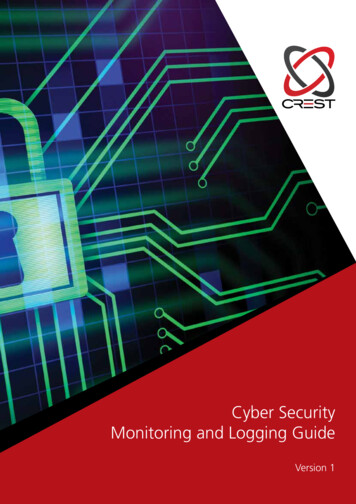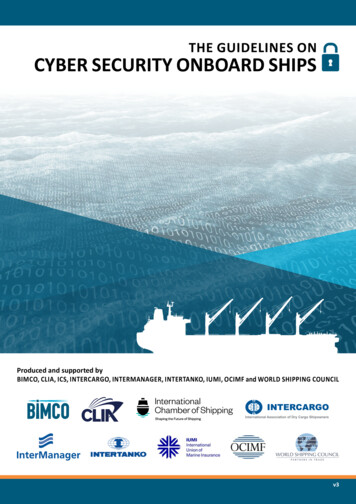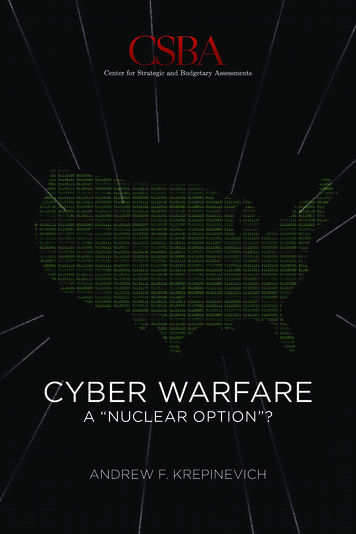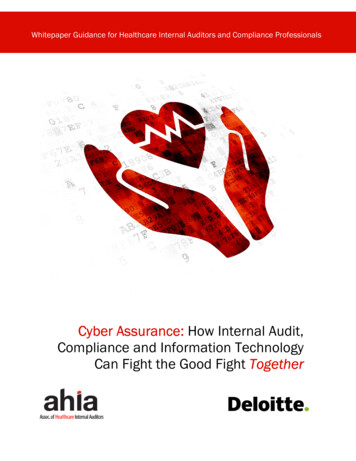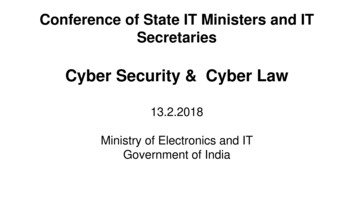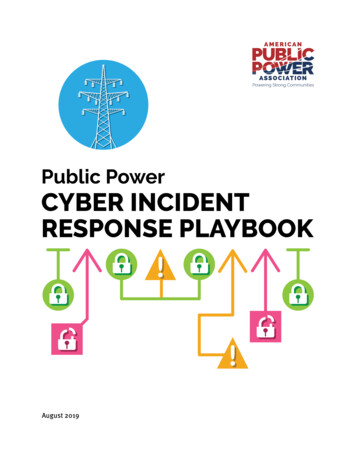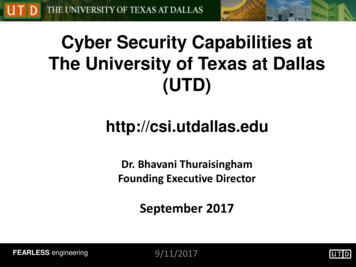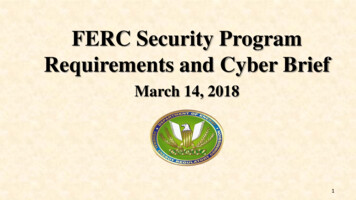
Transcription
CYBER CRIMESAND LAWS[As per New Syllabus (CBCS) for Third Semester, B.Com. (Pass),Delhi University w.e.f. 2015-16]Dr. U.S. PANDEYM.Sc., Ph.D. (Computer Science)Associate Professor,School of Open Learning,University of Delhi, Delhi.Dr. VERINDER KUMARM.Com., MCA, M.Phil., Ph.D. (Computer Science)Assistant Professor,IGIPESS,University of Delhi, Delhi.Dr. HARMAN PREET SINGHMBA, Ph.D.Assistant Professor,PGDAV College (M),University of Delhi, Delhi.ISO 9001 : 2008 CERTIFIED
AUTHORSNo part of this publication shall be reproduced, stored in a retrieval system, or transmitted in any form or by any means, electronic,mechanical, photocopying, recording and/or otherwise without the prior written permission of the author and the publisher.FIRST EDITION : 2017Published by:Mrs. Meena Pandey for Himalaya Publishing House Pvt. Ltd.,“Ramdoot”, Dr. Bhalerao Marg, Girgaon, Mumbai - 400 004.Phone: 022-23860170, 23863863; Fax: 022-23877178E-mail: himpub@vsnl.com; Website: www.himpub.comBranch Offices :New Delhi:“Pooja Apartments”, 4-B, Murari Lal Street, Ansari Road, Darya Ganj,New Delhi - 110 002. Phones: 011-23270392, 23278631; Fax: 011-23256286Nagpur:Kundanlal Chandak Industrial Estate, Ghat Road, Nagpur - 440 018.Phones: 0712-2738731, 3296733; Telefax: 0712-2721215Bengaluru:Plot No. 91-33, 2nd Main Road, Seshadripuram, Behind Nataraja Theatre,Bengaluru - 560020. Phones: 08041138821, 09379847017, 09379847005Hyderabad:No. 3-4-184, Lingampally, Besides Raghavendra Swamy Matham, Kachiguda,Hyderabad - 500 027. Phones: 040-27560041, 27550139; Mobile: 09390905282Chennai:New No. 48/2, Old No. 28/2, Ground Floor, Sarangapani Street, T. Nagar,Chennai - 600 012. Mobile: 09380460419Pune:First Floor, “Laksha” Apartment, No. 527, Mehunpura, Shaniwarpeth,(Near Prabhat Theatre), Pune - 411 030. Phones: 020-24496323/24496333;Mobile: 09370579333Lucknow:House No. 731, Shekhupura Colony, Near B.D. Convent School, Vikas Nagar, Aliganj,Lucknow - 226 022. Mobile: 09307501549Ahmedabad :114, “SHAIL”, 1st Floor, Opp. Madhu Sudan House, C.G. Road, Navrang Pura,Ahmedabad - 380 009. Phone: 079-26560126; Mobile: 09377088847Ernakulam39/176 (New No. 60/251), 1st Floor, Karikkamuri Road, Ernakulam, Kochi - 682011,Kerala. Phones: 0484-2378012, 2378016; Mobile: 09344199799:Bhubaneswar:5, Station Square, Bhubaneswar - 751 001 (Odisha). Phone: 0674-2532129;Mobile: 09338746007Kolkata:108/4, Beliaghata Main Road, Near ID Hospital, Opp. SBI Bank, Kolkata - 700 010.Phone: 033-32449649; Mobile: 09883055590, 07439040301DTP by:Sudhakar Shetty.Printed at:Shri Krishna Offset Press, Delhi. On behalf of HPH.
This book is dedicatedtoMy Mother&FatherAuthors(1) U.S. Pandey(2) Verinder Kumar(3) Harman Preet Singh
SYLLABUSB.COM., SEMESTER IIIPAPER BC3A (B): CYBER CRIMES AND LAWSDuration: 2 HoursObjective: This paper intends to create an understanding towards the cyber crimes and tofamiliarise the students with the application of cyber laws in general.CONTENTSUnit I: Cyber CrimesIntroduction — Computer Crime and Cyber Crimes: Distinction between Cyber Crimeand Conventional Crimes; Cyber Forensic; Kinds of Cyber Crimes — Cyber Stalking, CyberTerrorism, Forgery and Fraud, Crimes Related to IPRs, Computer Vandalism: Privacy ofOnline Data; Cyber Jurisdiction; Copyright Issues; Domain Name Dispute, etc.Unit II: Definition and Terminology (Information Technology Act, 2000)Concept of Internet, Internet Governance, E-contract, E-forms, Encryption, DataSecurity.Access, Addressee, Adjudicating Officer, Affixing Digital Signatures, AppropriateGovernment, Certifying Authority, Certification Practice Statement, Computer, ComputerNetwork, Computer Resource, Computer System, Cyber Appellate Tribunal, Data, DigitalSignature, Electronic Form, Electronic Record, Information, Intermediary, Key Pair, Originator,Public Key, Secure System, Verify, Subscriber as defined in the Information Technology Act,2000.Unit III: Electronic RecordsAuthentication of Electronic Records; Legal Recognition of Electronic Records; LegalRecognition of Digital Signatures; Use of Electronic Records and Digital Signatures inGovernment and its Agencies; Retention of Electronic Records; Attribution, Acknowledgementand Dispatch of Electronic Records; Secure Electronic Records and Digital Signatures.Unit IV: Regulatory FrameworkRegulation of Certifying Authorities; Appointment and Functions of Controller; Licenseto Issue Digital Signatures Certificate; Renewal of License; Controller’s Powers; Procedureto be Followed by Certifying Authority; Issue, Suspension and Revocation of DigitalSignatures Certificate, Duties of Subscribers; Penalties and Adjudication; Appellate Tribunal;Offences.
CONTENTSCHAPTER 1: CYBER CRIMES1.11.21.31.41.51.61 – 51Computer CrimeCyber CrimeComputer Crime and Cyber CrimeDistinction between Cyber Crime and Conventional CrimesCyber ForensicsTypes of Cyber Crimes1.6.1 Cyber Defamation1.6.2 Corporate Cyber Smear1.6.3 Forgery1.6.4 Cyber Pornography1.6.5 Cyber Stalking1.6.6 Online Gambling1.6.7 Online Sale of Illegal Articles1.6.8 Cyber Fraud1.6.9 Online Investment Fraud1.6.10 Spam and Phishing1.6.11 Spear Phishing1.6.12 Cyber Terrorism1.6.13 Social Engineering Identity Theft1.6.14 Cyber Extortion1.6.15 Intellectual Property Theft1.6.16 Computer Vandalism1.6.17 Computer Viruses and Worms1.6.18 Trojan Horses1.6.19 Logic Bombs1.6.20 Back Door1.6.21 Malvertising1.6.22 Hacking1.6.23 Theft of Internet Hours1.6.24 Salami Attacks1.6.25 Data Diddling1.6.26 Steganography1.6.27 Cyber Warfare1.7 Indian Laws on Cyber Crimes1.7.1 Legal Provisions Regarding Cyber Defamation and Corporate Cyber Smear1.7.2 Legal Provisions Regarding Forgery1.7.3 Legal Provisions Regarding Cyber Pornography1.7.4 Legal Provisions Regarding Cyber Stalking1.7.5 Legal Provisions Regarding Online Gambling1.7.6 Legal Provisions Regarding Online Sale of Illegal Articles
.111.12Legal Provisions Regarding Cyber Fraud, Online Investment Fraud and PhishingLegal Provisions Regarding Cyber TerrorismLegal Provisions Regarding Identity TheftLegal Provisions on Cyber ExtortionLegal Provisions Regarding Intellectual Property TheftLegal Provisions Regarding Computer VandalismLegal Provisions Regarding Viruses, Worms, Trojan Horses, Logic Bombs, BackDoor, Malvertising, etc.1.7.14 Legal Provisions Regarding Hacking1.7.15 Legal Provisions Regarding Theft of Internet Hours1.7.16 Legal Provisions Regarding Salami Attacks1.7.17 Legal Provisions Regarding Data Diddling1.7.18 Legal Provisions Regarding SteganographyPrivacy of Online Data1.8.1 Important Privacy Issues1.8.2 Privacy on the Internet1.8.3 Privacy Laws in India1.8.4 Constitutional Position of Right to Privacy in IndiaCyber Jurisdiction1.9.1 Legal Provisions Related to Cyber Jurisdiction1.9.2 Role Played by Indian Courts Regarding Cyber Jurisdiction1.9.3 Need of the Hour for India Regarding Cyber JurisdictionCopyright Issues in Cyberspace1.10.1 P2P Networks and Copyright Industry1.10.2 P2P Networks Legal Framework in India1.10.3 Digital Technology and Copyright Law: The Need for Balance1.10.4 Fair Use of Copyright MaterialDomain Name Disputes1.11.1 Definition of Domain Name1.11.2 Types of Domain Names1.11.3 Domain Name Disputes – Cybersquatting1.11.4 Dispute Resolution for gTLDs1.11.5 Dispute Resolution for ccTLDsSummaryCHAPTER 2: DEFINITIONS AND TERMINOLOGY (IT ACT, 2000) 52 – 822.12.22.32.4InternetInternet GovernanceDefinitionsE-contract2.4.1 IT Act Provisions for E-contracts in India2.4.2 Features of E-contracts2.4.3 Types of E-contracts2.4.4 Use of Digital Signatures for E-contracts
2.5 Encryption2.6 Data Security2.6.1 Pillars of Security2.6.2 Security Threats2.6.3 Causes of Security Threats2.6.4 Technology Solutions to Security Threats2.6.5 Security Policy2.6.6 Security Management2.6.7 Security Audit2.6.8 Cybersecurity and Legal Framework2.7 SummaryCHAPTER 3: ELECTRONIC RECORDS3.13.23.33.43.53.63.73.83.9Authentication of Electronic RecordsLegal Recognition of Electronic RecordsLegal Recognition of Digital SignaturesUse of Electronic Records and Digital Signatures in Government and its AgenciesRetention of Electronic RecordsPublications of Rules and Regulations in Electronic GazetteAttribution, Acknowledgement and Dispatch of Electronic RecordsSecure Electronic Records and Digital SignaturesSummaryCHAPTER 4: REGULATORY FRAMEWORK4.14.24.34.44.54.683 – 96Regulation of Certifying AuthoritiesAppointment and Functions of Controller4.2.1 Appointment of Controller and Other Officers4.2.2 Functions of Controller4.2.3 Recognition of Foreign Certifying Authorities by ControllerLicense to Issue Digital Signatures CertificateRenewal of LicenseController’s Powers4.5.1 Procedure for Grant or Rejection of License by Controller4.5.2 Suspension of License by Controller4.5.3 Notice of Suspension or Revocation of License by Controller4.5.4 Controller’s Power to Delegate4.5.5 Access of Computers and Data to ControllerProcedures to be Followed by Certifying Authority4.6.1 Duties of Certifying Authority4.6.2 Certifying Authority to Ensure Compliance of the Act4.6.3 Display of License4.6.4 Surrender of License4.6.5 Disclosure Requirements for Certifying Authority97 – 133
.8.3Suspension and Revocation of Digital Signatures CertificateCertifying Authority to Issue Digital Signature CertificateRepresentations upon Issuance of Digital Signature CertificateSuspension of Digital Signature CertificateRevocation of Digital Signature CertificateNotice of Suspension or Revocation of Digital Signature Certificate4.8Appellate TribunalEstablishment of Cyber Appellate TribunalComposition of Cyber Appellate TribunalQualifications for Appointment as Chairperson and Members of Cyber AppellateTribunal4.8.4 Term of Office and Conditions of Service of Chairperson and Members of CyberAppellate Tribunal4.8.5 Salary, Allowance and Other Terms and Conditions of Service of Chairperson andMembers of Cyber Appellate Tribunal4.8.6 Filling up of Vacancies of Cyber Appellate Tribunal4.8.7 Resignation and Removal of Chairperson and Members of the Cyber AppellateTribunal4.8.8 Orders Constituting Cyber Appellate Tribunal4.8.9 Staff of the Cyber Appellate Tribunal4.8.10 Appeal to Cyber Appellate Tribunal4.8.11 Procedure and Powers of the Cyber Appellate Tribunal4.8.12 Right to Legal Representation before Cyber Appellate Tribunal4.8.13 Limitation Act 1963 to Apply to Appeals to Cyber Appellate Tribunal4.8.14 Bar on Jurisdiction of Civil Courts4.8.15 Appeal to High Court against Decision of Cyber Appellate Tribunal4.9 Offences4.9.1 Tampering with Computer Source Documents4.9.2 Computer Related Offences4.9.3 Publishing of Obscene Information in Electronic Form4.9.4 Power of Controller to Give Directions4.9.5 Penalty for Misrepresentation4.9.6 Breach of Confidentiality and Privacy4.9.7 Penalty for Publishing False Electronic Signature Certificate4.9.8 Publication for Fraudulent Purpose4.9.9 Extra-Territorial Effect of IT Act4.9.10 Confiscation of Computer Related Equipments4.9.11 Non-interference of Compensation, Penalties and Confiscation with OtherPunishments4.9.12 Police Officer Empowered to Investigate Offences4.10 Summary
Chapter1Cyber Crimes1.1 COMPUTER CRIMEComputer crime is a growing threat to society caused by the criminals and irresponsibleactions of individuals who are taking advantage of the widespread use of computer networksin our society. It presents a major challenge to the ethical use of information technologies.Computer crime poses serious threats to the integrity, safety, and survival of most e-businesssystems, and thus makes the development of effective security methods a top priority.According to Association of Information Technology Professionals (AITP), computercrime includes the following: The unauthorized use, access, modification, and destruction of hardware, software,data, or network resources The unauthorized release of information The unauthorized copying of software Denying an end-user access to his or her own hardware, software, data, or networkresources Using or conspiring to use computer or network resources to illegally obtaininformation or tangible property.1.2 CYBER CRIMECyber crime encompasses any criminal act dealing with computers and networks (calledhacking). Cyber crime includes traditional crimes conducted through the Internet. Forexample, hate crimes, telemarketing and Internet fraud, identity theft, and credit card accountthefts are considered to be cyber crimes when the illegal activities are committed throughCYBER CRIMES1
the use of a computer and the Internet. Cyber crimes also includes offences that are committedagainst individuals or groups of individuals with a criminal motive to intentionally harmthe reputation of the victim or cause physical or mental harm, or loss, to the victim directlyor indirectly, using modern telecommunication networks such as Internet (chat rooms, emails,noticeboards and groups) and mobile phones (SMS/MMS).Cyber crimes may threaten a nation’s security and financial health. Issues surroundingthese types of crimes have become high-profile, particularly those surrounding hacking,copyright infringement, child pornography and child grooming. There are also problems ofprivacy when confidential information is intercepted or disclosed, lawfully or otherwise.Internationally, both governmental and non-state actors engage in cyber crimes, includingespionage, financial theft and other cross-border crimes. Activity crossing internationalborders and involving the interests of at least one nation state is sometimes referred to ascyberwarfare. The international legal system is attempting to hold actors accountable for theiractions through the International Criminal Court.1.3 COMPUTER CRIME AND CYBER CRIMEComputer crimes can involve criminal activities that are traditional in nature, such astheft, fraud, forgery and mischief, all of which are subject everywhere to criminal sanctions.The term computer misuse and abuse are also used frequently, but they have significantlydifferent implications. Annoying behavior must be distinguished from criminal behavior inlaw. As per IT Act, 2000, no description has been categorically made for computer crime andcyber crime. So till today, it is very difficult to differentiate between these two words. Inrelation to the issue of intent, the principle of claim of right also informs the determinationsof criminal behavior. For example, an employee who has received a password from anemployer, without direction as to whether a particular database can be accessed, is unlikelyto be considered guilty of a crime if he or she accesses those databases. So, a distinction mustbe made between what is unethical and what is illegal. The legal response to the problemsmust be proportional to the activity that is alleged. Common types of computer crimes are: Forgery; Fraud by system manipulation intentionally; Any modification to data or programs or databases; and Accessing computers without authorization;However, cyber crimes are somehow different from computer crimes. Computer crimehappens in physical space with or without the network. Cyber crime takes place in a virtualspace through digital environment. Recent example of cyber crime was Bazzee.com case,which is a MMS scandal. Cyber crimes may happen globally as there is no geographical limitfor cyberspace.1.4 DISTINCTION BETWEEN CYBER CRIME AND CONVENTIONAL CRIMESAlthough we talk about cyber crime as a separate entity to traditional crime, it is carriedout by the same types of criminals for the same type of reasons. These hackers are professional2CYBER CRIMES AND LAWS
thieves, criminal gangs, disgruntled employees, professional competition, activists, disillusionedyouth and state adversaries. They have the same motivations as traditional criminals suchas boredom and vandalism, ideological or political support, malice or revenge, monetary gainthrough extortion or sale of illegally obtained data, terrorism or notoriety and sensationalism.However, there are certain differences between cyber crimes and conventional crimes, whichare discussed below: Evidence of the offences: Traditional criminals usually leave traces of a crime,through either fingerprints or other physical evidences. On the other hand,cybercriminals rely on the Internet via which they commit their crimes, and it leavesvery little evidence about the cyber crime. Forensic investigators usually experiencegreat difficulty in gathering evidence that could lead to the conviction ofcybercriminals since these criminals can freely change their identities. The Internetalso allows the anonymity of its users, and this implies that cybercriminals can useany pseudonyms for their identification. On the other hand, it is difficult fortraditional criminals to fake their gender, race, or age. Length of investigations: Since cyber crime involves perpetrators using falsifiednames and working from remote locations, it usually takes longer to identify thereal cybercriminals and apprehend them. In most cases, cybercriminals (such ashackers) escape from arrest because the investigators cannot locate them. Traditionalcrimes take shorter time period to investigate because the criminals usually leaveevidence that can be used to spot them. For instance, traditional criminals can leaveevidence such as DNA, fingerprints, photographs and videos captured onsurveillance cameras, or personal belongings such as identity cards, and this makesit easy for investigators to identify and capture the culprits. In addition, suchevidence makes it easy for the judiciary to convict the offenders. Constitutional law provisions: Article 20(3) of the Indian constitution deals withthe privilege against self-incrimination. According to this article, “No personaccused of any offence shall be compelled to be a witness against himself”.Consequently, cybercriminals can use this legal provision to deny the investigatorsany incriminating evidence that could lead to the prosecution of the cybercriminals.This implies that even in situations where cybercriminals are apprehended, the trialprocess may take long unless the investigators gathered irrefutable evidence aboutthe crimes. Use of force: Most of the traditional crimes (such as rape, murder, arson, andburglary among others) involve the use of excessive force that results in physicalinjury and trauma of the victims. On the other hand, cyber crimes do not requirethe use of any force since the criminals merely use the identities of their victims tosteal from them. For example, cybercriminals use spoofing and phishing to obtainpersonal information such as credit card numbers from their victims, or useencrypted emails to coordinate violence remotely. Scale of attacks: Cyber-attacks can be conducted on a scale not possible in thephysical world. A traditional bank robber may only be able to hit one or two banksa week, a cyber-attack can target 100s if not 1000s of sites at once.CYBER CRIMES3
Reach of attacks: Cyber-attacks can be performed from anywhere in the world; theycan be performed anonymously and within jurisdictions where the consequences ofthose actions may not, or cannot, be addressed by the criminal justice system.Attackers are also able to extract far more data digitally than would ever be possiblein the physical world. For example, 1 gigabyte of data is approximately 4,500paperback books. Think of how many gigabytes of data is held on a system, hackerscan extract this within a matter of minutes. Speed of attacks: Cyber-attacks are conducted at machine speed; a criminal canwrite a piece of code that can target multiple sites in minutes. Perception and media effect: The public and media perception of cyber crime isdifferent from a conventional crime. When large financial institutions have beenhacked, the media has often wholly apportioned blame to the organizations ratherthan the criminals; this would not be the case in a physical bank robbery.1.5 CYBER FORENSICSCyber forensics (or computer forensics) is the application of investigation and analysistechniques to gather and preserve evidence from a particular computing device in a way thatis suitable for presentation in a court of law. The goal of computer forensics is to performa structured investigation while maintaining a documented chain of evidence to find outexactly what happened on a computing device and who was responsible for it.Forensic investigators typically follow a standard set of procedures. After physicallyisolating the device in question to make sure it cannot be accidentally contaminated,investigators make a digital copy of the device’s storage media. Once the original media hasbeen copied, it is locked in a safe or other secure facility to maintain its pristine condition.All investigation is done on the digital copy.Investigators use a variety of techniques and proprietary software forensic applicationsto examine the copy, searching hidden folders and unallocated disk space for copies ofdeleted, encrypted, or damaged files. Any evidence found on the digital copy is carefullydocumented in a “finding report” and verified with the original in preparation for legalproceedings that involve discovery, depositions, or actual litigation.The need or the importance of the computer forensics is to ensure the integrity of thecomputer system. The system with some small measures can avoid the cost of operating andmaintaining the security. The subject provides in-depth knowledge for the understanding ofthe legal as well as the technical aspects of computer crime. It is very much useful from atechnical point of view.The importance of computer forensics is evident in tracking the cases of childpornography and email spamming. Computer forensics has been efficiently used to trackdown the terrorists from the various parts of the world. The terrorists using the Internet asthe medium of communication can be tracked down and their plans can be known.There are various tools that can be used in combination with the computer forensicsto find out the geographical information and the hideouts of the criminals. The IP address4CYBER CRIMES AND LAWS
plays an important role to find out the geographical position of the terrorists. The securitypersonnel deploy the effective measures using the computer forensics. The IntrusionDetecting Systems are used for that purpose.A number of techniques are used during computer forensics investigations such as: Cross-drive analysis: It is a forensic technique that correlates information found onmultiple hard drives. The process, still being researched, can be used to identifysocial networks and to perform anomaly detection. Live analysis: It involves examination of computers from within the operatingsystem using custom forensics or existing system administration tools to extractevidence. The practice is useful when dealing with Encrypting File Systems, forexample, where the encryption keys may be collected and, in some instances, thelogical hard drive volume may be imaged (known as a live acquisition) before thecomputer is shut down. Deleted files: It is a common technique used in computer forensics to recover thedeleted files. Modern forensic software have their own tools for recovering orcarving out deleted data. Most operating systems and file systems do not alwayserase physical file data, allowing investigators to reconstruct it from the physicaldisk sectors. File carving involves searching for known file headers within the diskimage and reconstructing deleted materials. Stochastic forensics: It is a method which uses stochastic properties of the computersystem to investigate activities lacking digital artifacts. Its chief use is to investigatedata theft. Steganography: It is one of the techniques used to hide data via steganography. Itinvolves the process of hiding data inside of a picture or digital image. An examplewould be to hide pornographic images of children or other information that a givencriminal does not want to have discovered. Computer forensics professionals canfight this by looking at the hash of the file and comparing it to the original image(if available). While the image appears exactly the same, the hash changes as thedata changes.1.6 TYPES OF CYBER CRIMESThere are many types of cyber crimes and the most common ones are explained below:1.6.1 Cyber DefamationEvery individual has a private right to protect his reputation. Every individual has aright to its own personal space and he would not want others to interfere in that ‘space’.However, a public right to freedom of speech and expression guaranteed under Article19(1)(a) of the Constitution of India makes enforcement of our private right a challenge. Adelicate balance has to be maintained. The law of defamation has been designed to protectthe reputation of an injured person and provide such balance between private and publicrights by giving him the right to sue for damages.CYBER CRIMES5
Defamation comprises of both slander (defamation by speaking) and libel (defamationby means of writing). Slander involves the oral “publication” of a defamatory remark thatis heard by another, which injures the subject’s reputation or character. Slander can occurthrough the use of a hand gesture or verbal communication that is not recorded. Libel, onthe other hand, is the written “publication” of a defamatory remark that has the tendencyto injure another’s reputation or character. Libel also includes a publication on radio, audioor video. Even though this would be considered oral, or verbal, communication to someone,it is actually considered to be libel because it is published in a transfixed form.In the good old days, slander was more popular and possible. After the popularity ofthe printing press, one witnessed the increase in libel. With the advent of informationtechnology and the Internet, libel has become much more common and of course, easier. Inthis context, arises cyber defamation. In simple words, it implies defamation by anythingwhich can be read, seen or heard with the help of computers/technology. Since the Internethas been described as having some or all of the characteristics of a newspaper, a televisionstation, a magazine, a telephone system, an electronic library and a publishing house, thereare certain noticeable differences between online and offline attempt of defamation whichmakes the online defamation more vigorous and effective.Quantitatively, a comment defaming a person can be sent to a large number of personsthrough email by a click of the mouse. Much easier would be to publish it on a discussionboard known to be visited by thousands of persons every day. On the number game, it isstill more convenient to make available the defamatory sentence to millions of people bymerely publishing it on the website. The number of people a comment defaming a personmight reach is gigantic and hence would affect the reputation of the defamed person muchmore than would an ordinary publication.Qualitatively, the impact of an online comment defaming a person would again dependupon the fact as to where it has been published. Putting a defaming message in specific anewsgroups (for example, a lawyer’s group in case one wants to defame a lawyer) wouldnecessarily have a more effective negative impact on the reputation of the person beingdefamed rather putting the same on a ladies’ kitty party group.1.6.2 Corporate Cyber SmearHarmful, defamatory, insulting or offending online message has been termed ascorporate cyber smear. It is a false and disparaging rumor about a company, its managementor its stock. This is commonly done through the internet via websites, blogs, forums, emailsand instant messaging, chat rooms and now in the social networking sphere. This kind ofcriminal activity has been a concern especially in stock market and financial sectors whereknowledge and information are the key factors for businessmen. Persons indulging incorporate cyber smear include disgruntled employees or insiders, ex-employees, enviousex-colleagues, impostors, competitors, creditors, and even those seeking a forum when theyare denied employment or former shareholders.False and defamatory statements made against Amazon Natural Treasures Inc. led toa stock price decline from an April 1997, 52-week high of 3.56 per share to approximately6CYBER CRIMES AND LAWS
12 cents per share. The low stock price led to a delisting from the OTCBB to the pink sheets.It transpired that the statements were made by the owner of Demonte & Associates, a NewYork public relations firm, who claimed that a collection agency was suing Amazon for about 7,000.1.6.3 ForgeryForgery is defined as the criminal act that includes the purposeful defrauding,misleading, deception, and misrepresentation of a product, service, or item with the intentto deceive. The scope forgery is a vast one; forgery can include the production of falsifieddocuments, counterfeited items — products intended to resemble other products, and themisrepresentation of fraudulent identification.The criminal act of forgery can take place in a variety of settings. However, with regardto identity theft, the act of unlawfully recreating the likeness of the signature belonging toanother individual or entity with the intent of providing deceitful authorization for economicgain is one of the foremost methodologies undertaken. Desktop publishing systems, colorlaser and ink-jet printers, color copiers, and image scanners enable crooks to make fakes, withrelative ease, of cheques, currency, passports, visas, birth certificates, ID cards, etc.Forgery could be of various types: Electronic forgery: The misuse of computer networks, the internet, and variousavenues within the online community in order to defraud potential victims ofidentity theft is classified as electronic or online forgery. Electronic forgery is quitecommon within the digital age, which can include the illegal
1.2 Cyber Crime 1.3 Computer Crime and Cyber Crime 1.4 Distinction between Cyber Crime and Conventional Crimes 1.5 Cyber Forensics 1.6 Types of Cyber Crimes 1.6.1 Cyber Defamation 1.6.2 Corporate Cyber Smear 1.6.3 Forgery 1.6.4 Cyber Pornography 1.6.5 Cyber Stalking 1.6.6 Online Gambling 1.6.7 Online Sa


